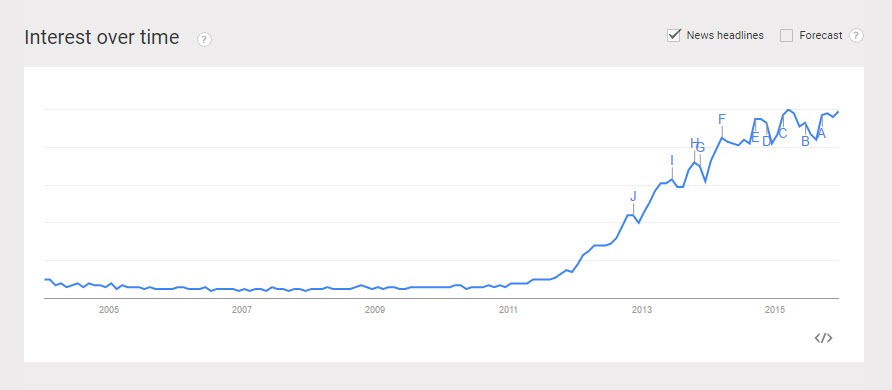In project management a lot of what we do is looking forward. We look into the future and try to predict what risk is going to hit tomorrow, and what is going to stop us from hitting the budget targets and deadlines that have been set.
We do look backwards—when we get a moment—through project retrospectives, sprint retrospectives and formal lessons learned or post-implementation reviews. In my experience, these tend to be hurried and the learning isn’t always carried forward as well as we’d like. I’d go as far as to say that overall, project teams are not that great at looking backwards, otherwise we’d see far higher success rates in projects.
Today I do want to look backwards, but in a different way. It’s the end of the year, and it’s kind of traditional to reflect on what’s happened during the previous 12 months.
Here’s my Year in Review for the world of project management in 2015.
Executing on strategy
While there’s always been a lot of talk at an individual level around leadership, at a company level the top project management trend this year was strategy execution.
Leaders at the top seemed to have had a lightbulb moment: What’s the good of a strategy if you can’t turn it into reality? The result is a closing of the gap between the C-suite and the operational teams to make good on the vision.
PMI’s 2015 report, Capturing the Value of Project Management (available on the PMI Pulse website) concludes that sharing the vision is critical to successful project outcomes. When decision makers are familiar with corporate strategy all the time, 78 percent of projects meet the original goals; 66 percent are within budget and 61 percent finish on time. The flip side of those figures is that when decision makers are operating without knowing about the strategy, their projects only meet the original goals 43 percent of the time; only 31 percent hit their budget and only 27 percent deliver on time.
Another PMI report, Enabling Organizational Change Through Strategic Initiatives, calls out that only 52 percent of strategic initiatives are successful. When strategic projects fail, the cost is huge. PMI’s figures show that nearly 15 percent of every dollar spent on strategic projects is thrown away due to poor project performance. That equates to $149 million of every billion dollar spent on projects.
Do you understand your company strategy enough to be making the right decisions and not throw money away?
Big data
WANTED Analytics, a company that crunches recruitment data, reported that demand for hiring experts in predictive analytics went up 63 percent against last year. Predictive analytics is the work of taking data and extracting patterns with the aim of understanding more about future activity. It’s especially useful for understanding what customers will do and how your products will perform. In other words, it’s a job for someone who uses what you will know as Big Data.
Statistics like this mean that it’s been hard to avoid media coverage of Big Data (they’ve even managed to tie big data into the seasonal flu epidemic). IT projects have been focused on making sure that data is accessible, and can be used to gain the kind of insights about how the business works that will really make a difference.
It’s the same for government too. The Notice and Comment project is an online portal bringing together thousands of local and federal regulations and public notices. Want to know what the President’s Council of Advisors on Science and Technology talked about? It’s a click away.
Aside from the benefits of natural language searches, and analytics improving transparency in policy making, the site believes it can save money. It says that U.S. taxpayers spent $2.5 billion on posting public notices in local newspapers over the last five years. This figure that will drop dramatically by moving notices online.
On a smaller level, you’ve probably noticed that this year your managers and colleagues seem more open to cloud solutions and more prepared to talk about data, even if they aren’t from a technology background. That will carry on into 2016.

Security
IT project teams have to be careful about online security today more than ever. A number of high profile hacking scandals have shown that we can’t be complacent. British broadband provider TalkTalk was hacked this autumn, the third time in a year that the company has been subjected to a cyber-attack. Around the same time, T-Mobile U.S. Inc. and Experian were suffering from similar breaches.
As a result, when I’ve spoken to project managers this year they’re now advocating that these non-functional requirements are written into the scope of their projects. While I don’t have the data to back it up, I’m sure that working in the penetration testing business was great this year!
Overall, I think it has been a good year for project managers. Our professional bodies continue to support us. Our tools continue to evolve and become even better. Our managers seem, for the most part, cognizant of the increasingly important role that projects and teams play in turning strategy into reality through realistic planning and delivery.
International Project Management Day
The biggest thing to happen in project management at the end of the year has been International Project Management Day (IPMD). This was celebrated internationally starting on November, 5 and all through the month of November.
There were events all over the world and online, hosted both by professional bodies such as PMI Chapters and companies recognizing the efforts of their own staff.
IPMD is important because it raises the profile of the project management industry and those of us working in project management jobs. It’s been going since 2004 and each year there are more and more (and bigger and bigger) events. Many of them are free and offer project managers an easy way to network and meet people facing similar struggles. This is particularly helpful for project managers in small teams and technical teams where you might not have anyone else in your business doing the same role as you. Mark your calendars for November 3, 2016!
PMI Fellow and IPM Day Founder talk about achieving business value through portfolio management in this webinar recorded on the day.
Happy International Project Management Day, everyone! Make sure to give your project manager a high-five on this special occasion. #IPMDay
— LiquidPlanner (@LiquidPlanner) November 1, 2012
Awards and prizes
The big awards event in the global project management calendar is the PMI Professional Awards. Project of the Year this year went to the El Segundo Refinery Coke Drum Reliability Project, based in El Segundo, CA. The team upgraded the refinery on a really short timeline, and still managed to finish ahead of schedule, under budget and with a perfect safety record.
IT projects were also represented among the winners. The Navy Federal Credit Union took home PMO of the Year, demonstrating how a PMO can help align IT projects to a strategic vision.
The International Project Management Association (IPMA), which many national project management organizations belong to, also hosts awards for project excellence. This year Sberbank of Russia, a banking and financial services firm headquartered in Moscow, won the Mega Project category for their work transforming the core banking system and IT architecture. The Incheon Bridge Project in South Korea took the top award for an outstanding project with a sustainable impact.
Many national groups held local project management awards, and other industries recognized the importance of project management. For example, the British Construction Industry Awards had a project management category for the first time.
LiquidPlanner shouldn’t go unmentioned in this section! Our very own predictive project management tool won a prestigious CODiE award for best project management software this year.
The best books
I’ve read a lot of books this year. There were some great releases in 2015.
Cesar Abeid’s book, “Project Management for You,” is a valuable introductory (or refresher) read for someone starting out in project management. It’s very practical, and it’s easy to see how it could apply to IT and non-IT projects. [Editor’s note: Cesar also contributes to this blog.]
“Not Knowing: The Art of Turning Uncertainty Into Opportunity,” by Steven D’Souza & Diana Renner, won Management Book of the Year 2015 and it’s easy to see why. It’s a book about why you don’t have to have all the answers. In a project environment, it’s normal to not have all the answers. If that makes you feel uncomfortable, this book might help you understand how to turn that to your advantage.
Project Leadership, by Donnie MacNicol and Sarah Coleman, was fully revised and updated for a third edition. The book has been around a while but we’ve definitely seen a focus on leadership over the last 12 months, so this new release was timely.
What do you think of the state of project management as 2015 draws to a close? Let us know in the comments.
And here’s to a great 2016!







